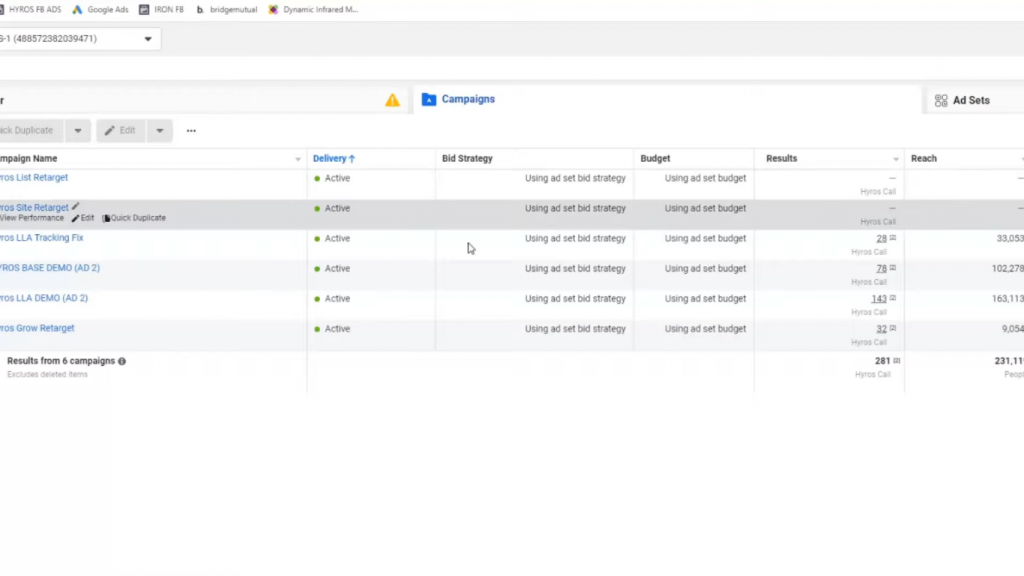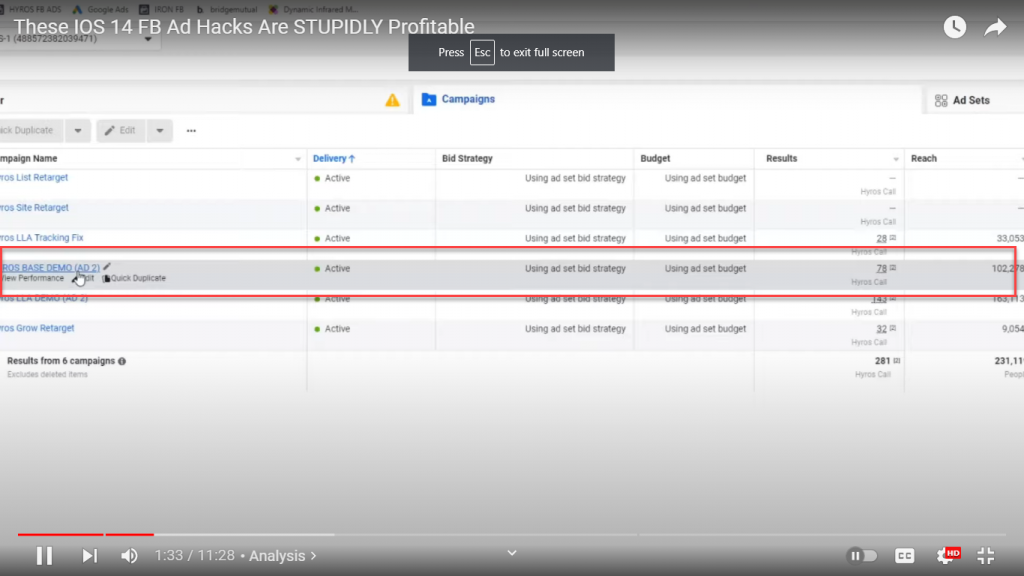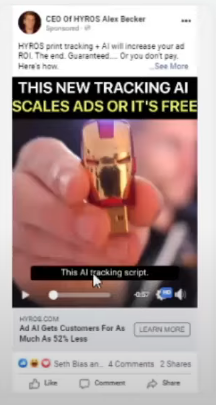
These Facebook Hacks Are KILLING IT Post IOS Update
So, on the Hyros forum, I’m seeing all sorts of comments about the effects of the iOS update … “My ads have been totally ruined no thanks to iOS … I can’t target anymore …”
And I swear … I hear all these comments in the same overly deep voice. It’s really weird. I’m telling you, even the girls are talking in that extra bass voice. Then again, maybe that’s just in my head when I read the comments.
Look, here’s the deal. I’m going to tell you a bunch of things that will make your ads perform a lot better on Facebook—even during iOS. And it actually doesn’t come down to advanced changes or anything like that.
I’m just showing you different audiences and little tweaks I’ve made that have given me bigger improvements and frankly, have allowed my ads to be doing a little bit better than they had before iOS came into the picture.
Now, of course, using Hyros and its attribution metrics, I’m still able to see my attribution super clearly. And so I’m not really gonna be focusing on that. If you’re having trouble seeing your ad results or making good decisions, just get Hyros. We literally guarantee you’re gonna see a 15 to 20% increase in your ROI. I use it specifically for that.
But today, I’m focusing more on audiences and targeting. And so without further ado, let’s just get into it.
Okay, guys. So we’re discussing one of my smaller ad accounts. Let’s look at what’s going on here.
Understanding The Facebook Ads Account

The first thing I’ve really noticed after this update is that lookalike audiences are really outperforming standard targeting audiences. Now, this was pretty much the case before, this isn’t something that hasn’t previously existed.
But if you look at our base audiences (which are going to be the standard targeting audiences)

we’re talking about targeting Shopify, targeting people that run paid ads. Let’s say I’m using just a basic, good old bare-bones Chimpanzee audience like Marketo. It’s a super duper basic audience. This was doing really well before the update. So if we go back and look at the campaign, this was doing great.
Now, look, everybody acts like they understand exactly why this is happening. And I’m going to be straight-up transparent with you, it could be a whole range of things. Obviously, the most basic thing happening is that Facebook just simply isn’t able to target the way it used to—especially when it comes to a list of people. Retargeting was something that took a big old doozy.
But if you were to take a snapshot of the last fourteen days, you can see this really increased a lot for me, while my look-alike audiences have gone down a lot. And you can even see the past few days, this hasn’t been great. Now, comparatively, for me, this is still a great cost per call. For me, this is absolutely fine. I’m just referring to this.
Again, we’re using Facebook’s conversions right here. Nine out of ten times, I’m gonna be using Hyros conversions for these because Facebook is just wildly inaccurate with their conversions, they over-report like crazy due to view-throughs. Okay, that’s one thing you need to be looking at more.
And I guess I’ll just talk about it right now.
Is Facebook Ad Reporting Accurate?
Whenever you go and look at your actual metrics—especially if you have a business with crisscrossing ads—you’ll see that it wasn’t this bad before. In fact, Facebook has under-reported a lot in the past, but it seems like they’re over-reporting has gone insane.
Now, is this because they want to still seem like they’re getting good results? I don’t really know. But I’ve seen over-reporting on Facebook just get too silly levels. Like right here, I can track where every single call on Hyros came from, I can click right here.

I’m not gonna look it up because you’ve probably seen me do it 1000 times in other videos, but I can see people’s entire click History, every ad they’ve interacted with, and all the devices they’re using. A lot of times when you have crisscrossing businesses, especially businesses that have a lot of organic traffic as Hyros does, you’re going to start seeing a lot of over-reporting on Facebook. So again, you need to be super careful with this because it’s gotten to a level that’s inappropriately high recently, from my point of view.
Using Look A Like Audiences More Effectively
Now, the next thing I’ve seen that’s really helped a lot and improved results are creating bigger lookalike audiences. So, you can see that we’re going to be echoing off of Facebook numbers right here, which are not really that accurate. The cost per call is a little bit higher on all of these.
That being said, I’ve been getting really good results by increasing to the 5%. And I’m trying to go up to the 7% range now with our lookalike audiences. I think what’s also happening right here is that Facebook literally has smaller lists to work with. When they were able to target people on apps, on phones, and all the things that are being cracked down on, they just had a larger list of people. So you had more people you could run ads to.

I think in order to make Facebook work a little bit better, you need to give Facebook a larger list of people to be targeting. When you do this it can still find people, and it can still use its conversion targeting to do pretty well there—especially if you’re passing that data back from an attribution tool. The one thing that’s just worked a lot better for me is just increasing the audience sizes.
I want to show you one thing that’s worked really badly for me. In the past, I used to really want these ad sets to only target the people that I wanted to target. So I would usually block exclusions. I wouldn’t give Facebook the ability to go way outside the interest range that I put in there. Every campaign that I’ve had the interest range blocked on has done a lot worse than ones that had them.
What To Do With Your Customer List!
Now, the final thing I’m gonna lay out there is having customer lists and using customer lists primarily for retargeting, which I’m doing a lot of right now. It has been working a lot better than retargeting people that just bump onto my page, or something like that. It’s a simple statement to make. But I really used to focus more on website retargeting and list retargeting as it has been working a lot better.
So if you have an email list, you’re collecting emails and you’re collecting actual customer data, I think that gives Google—I think it gives Facebook—a much better direction to target than simply using the website retargeting, which is again being a little bit messed up by iOS because it’s not tracking people landing on apps. And that is due to the fact that a big chunk of Facebook’s targeting and audience collection via Pixels has been knocked out a little bit by the iOS update.
So that’s another thing right there.
Now there are just a few things I think you should really look at with your ads. The thing I constantly see people attempting to do is to try to find the reason why their ads aren’t working. But you have to think about what’s going to happen if you find the reason why your ads aren’t working … You’re probably not able to fix it because Facebook is just gonna keep working like it’s working right now. The end.
The Secret Sauce for Improving Your Ads!
The most important thing you could do is improve your ads.
Let me tell you a few things I’ve done that have really helped out. One of the things that helped out the most (and I’m doing it in this campaign right now) is reducing the amount of ads inside of ad groups. Now you might not have this problem … But when I’ve done this, I’ve seen it do a lot better.
Okay, so what I do is I just go in and clear the ads that are kind of messy. Sometimes people like to have like seven different ads on there. I’m really finding that at around three to four ads is where we’re getting the best results. On top of that, check out this video ad right here. This thing has done extremely well for me lately.
And if you apply these things to your ads—even without changing the scripts, even without changing the copy—you’re probably going to start seeing better results.
Check out this ad right here on this corner.

This thing has given me significantly better results than my other ads, but it has the same exact ad script, copy, and everything. On the retargeting side, I see image ads do much better because all you’re trying to do is remind people. That’s just a general tip right there that can help you through ads right now. (I’m not usually seeing image ads do better on the cold targeting side.)
Video Ad Tricks On Facebook
So with your ads, make sure you’re running video ads. First off, those are doing better on Facebook right now. On top of that, when you have a video ad, consider what the thumbnail looks like. Is there a clear hook text-wise in the thumbnail? Is there an image that stands out?
Check this out. This is important when it comes to advertising. If you go and compare this ad to this ad right here, you’ll see that the other ad starts off with a blurry image of a non-unique thumb drive. Okay, so I took that and I put an Iron Man thumb drive that stands out, especially from the background, you can see there are a lot of bright lights and everything.
But it’s blurry in the background, you become super focused on this, and it catches the eye so the person reads it. This is so important when it comes to video ads. Simply making changes like this on my ads and thinking, How are people going to scroll past? and How can I grab their attention more effectively? has plummeted a lot of my cost-per-calls because more people are clicking the ad, and more people are paying attention.
And so if you really want to do well in this update, do those things I just talked about, and improve the audience size, start focusing a little bit more on lookalike audiences, particularly of buyers. Buyer-lookalike audiences have been doing very, very well for me. Go through your ads and look at where you can simply improve them by dropping 20 to 30% of your costs on ads simply by making better headlines, making better video thumbnails, and making sure it stands out.
This AI tracking has extremely clear text. Now, I used subtitle generation software to get a text that looks like this. Facebook is not going to give you text that is this clear. You want to make the video have this right here.

This is what works: having that, having strong call-to-actions, focusing on using the scripts that I talked about on this channel as well (my exact YouTube and Facebook ad scripts are on this channel), that’s going to improve your ads well enough that you’re not going to eat maybe the amount of doodoo you’re already eating on this update.
I see a lot of people struggling, and there are all sorts of things we can talk about as to the reason why … Facebook’s lack of targeting or you can’t get the results you did before. I’m doing just fine. Our ads are doing just fine. And we’re actually getting lower cost-per-calls now because I put even more effort into my ads.
I think what is mainly going on is that the list of people Facebook can accurately target is much smaller than before, so it’s getting more competitive and ad cost is increasing. Give Facebook larger lists to work with and make sure your ads are better because it’s more competitive now due to the fact that it can’t target as many people as accurately as it used to. I think a lot of people have uncompetitive ads and are paying the price for not having competitive ads.
That’s it. That’s all for today, guys.
How Hyros Amplifies Your Results
Okay. It’s not quite all. I mean, obviously, another tip I could give you, which I give in every video, is to use attribution. Use something like Hyros. If you’re not working off the correct data from your attribution, you’re going to lose 15 to 20% of your ad spend, you’re going to kill campaigns that you should be scaling, and cutting another 15 to 20% of profit off your ad account. If you just fix your attribution and have accurate data, you don’t have that, and that really helps a lot. Next to 30% of margins is really useful when you’re scaling up ads.
That being said, guys, if you want to see for yourself, check out all the tutorials and courses on this channel, all my Facebook copywriting, and all my YouTube copywriting. It’s all here, and I’ve done a lot of sales.
On top of that, if you want to get actual help with it, join my mastermind below. Look at all the results, with more results when it comes to YouTube ad scaling than any other mastermind on planet Earth.
So you should check it out. That being said, subscribe to this channel. I release videos like this every single week, and you’re going to want to see them because they’re really good. I’ll see you at the next one. Take it easy.
HYROS TRACKING
If you are interested in obtaining the same stats I showed in this video and even having us help you set this up, GO HERE to get more information on HYROS.
Ad Training and Tactics
While I do not sell courses, I do offer a private coaching program where I train people on the ad strategies I have used to build multiple 8 figure and 7 figures businesses. You can get more details on that HERE.
HYROS Facebook Group
It’s really simple. This group is the best media buyer Facebook group online because we make sure that every member is spending significant ad spend before joining. It’s for veteran ad buyers only and because of that the networking/information being shared is on another level. You can apply to join HERE
Here Are Our FULL Zero To Scaled Ad Courses (Free)
The Zero To SCALED Facebook Ads Course (Advanced FB Scaling)
The Zero To SCALE Youtube Ads Course (Advanced YT Scaling)
Here Are Some Other Post You Will Enjoy
Using AI + Print Tracking Is The Ultimate Scaling Edge In 2020-2021
My Top 3 Highest Converting Youtube Ads Of All Time
The Highest Converting Ad Opt In Existence
How I Scaled To 8 Figures On Youtube With BROAD Keywords
$15,000 On EACH. Youtube VS Facebook Ads In 2020 Case Study
